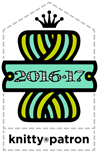Feature: Get Warped. Free weaving tutorial about how color appears in woven fabric by rigid-heddle loom expert Liz Gipson
Get Warped
Get Warped: A Theory About Color for Weavers
I'm going to say this straight off: this column is not about color theory. Beyond this one sentence, I'm not going to mention the color wheel or analogous, complementary, and harmonious colorways. This column outlines the ways that color is affected by weaving itself.
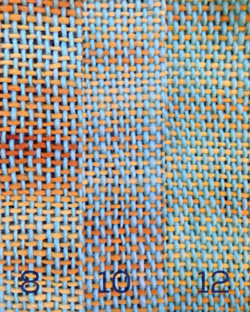
In weaving, yarns are interlaced with one another, causing the eye to see the cloth as a blending of both colors. How a color appears in woven cloth is affected by the proportion of warp to weft.
Sett
Sett has a profound effect on color. In this example, Brown Sheep Company's sport weight Lanaloft is used in warp and weft. As seen on the the loom in the image (at right) at far left, is a sett of 8 ends per inch, an open sett for this yarn; in the middle is a sett of 10 ends per inch, balanced sett for this yarn; and at the far right is a sett of 12 ends per inch, a close sett for this yarn.
In an open sett, the weft yarns dominate, in a balanced sett, neither color dominates, and in a close sett, the warp is more prominent.
(If you need a refresher on sett, check out the First Fall 2015 Get Warped column.)
Structure
Structure also affects how color is seen. These samples are warped in Berroco Indigo, which is 100% recycled recycled fibers. Each swatch is woven in a different weave structure using Classic Elite Seedling, which is 100% organic cotton. These swatches are off the loom and washed. From left to right are spot weave, twill, plain weave, and lace. The color dominance and appearance shifts depending on the proportion of warp to weft.
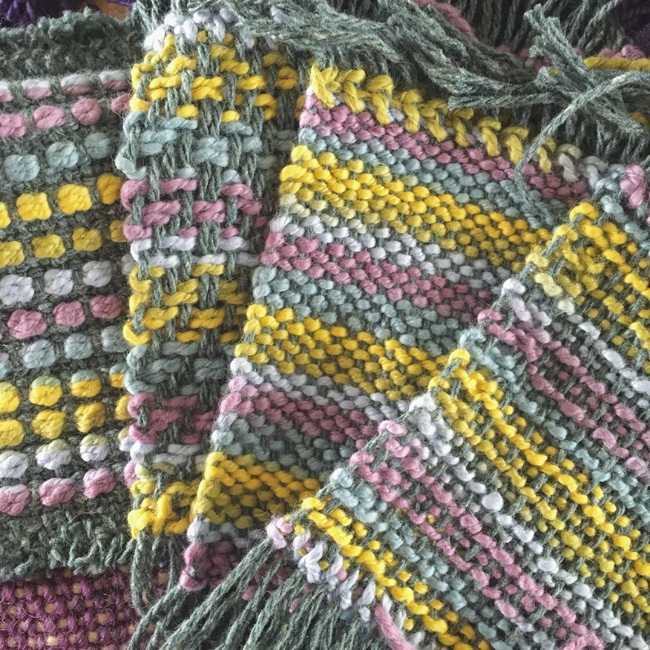
Color
This may seem a bit obvious, but color also affects color. Gil, one of my New Mexico Tech students from Spring semester last year, modified the stripe pattern and colors of the Dealer's Choice Towels from the revised edition of Weaving Made Easy, to match his Fiestaware. He used the same yarns called for in the pattern: Lion Brand Kitchen Cotton in the warp and unmercerized 8/2 cotton in the weft. By changing the weft color for each towel, he was able to shift the appearance of the warp stripe, sometimes pretty dramatically.
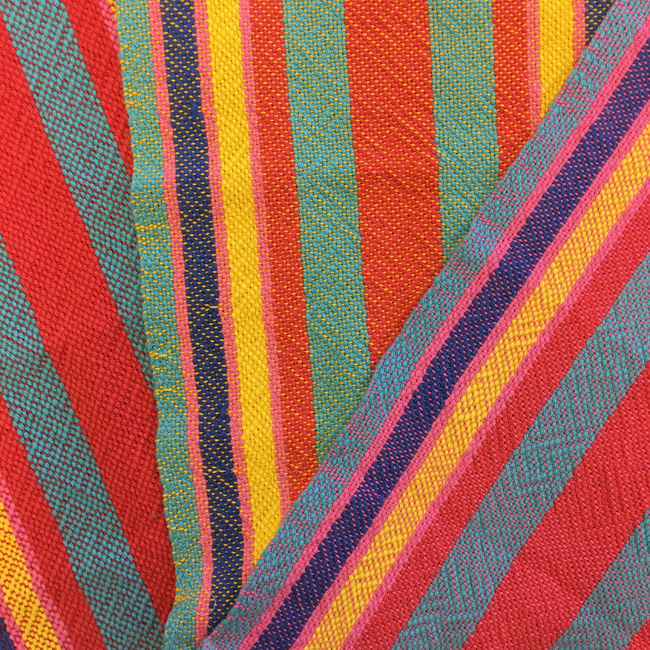
How I Choose Color
While we can dream up many pleasing many color combinations, we are often faced with limited color choices based on available yarns. Given that we can't have any color we want unless we dye it ourselves, what is a weaver to do?
When I was in college I was a dye-hard natural dyer (pun intended). This choice wasn't because I was au natural, but because I lacked color confidence. My professor once said in passing that natural dyes never clash. After hearing that, I was all-in. Nature really knows what she is doing when it comes to color. (It was a good thing, too, because when my college hosted Nature's Dyes, an Interweave conference on natural dyeing, I got a plum volunteer assignment that led to my job at Interweave.)
When I start thinking about designing a new project, I'll get out my camera and take a walk, or scroll though my camera looking at photos I've taken on previous excursions. You can do this with any photo or image. It doesn't have to be nature, but that is what works best for me. When I see a color combination I like, I will either take the photo with me while shopping for yarn, or match it to my stash yarns. The match doesn't have to be exact nor do you have to pick every color in the photo. In this example the blue green and green is not in the photo, but it worked well with the other colors. By using this method, I discover combinations that I may not have thought of before.

I also pay attention to the proportion of one color to another in the photo. Is there one color that dominates and another that acts as an accent? I'll use this information to plan out plaids, stripes, and other combinations.
Sometimes I work this system in reverse. When you buy yarn online, you can't always tell its true color. I shop for bases I like—the yarn size, content, and style—and then take my best shot at picking color. If I find, once I have the yarn in hand, that the color is really different from what I thought it would be, I'll scroll through my photos to find something close to it and work from there.
You can get some idea about how colors will interact with one another on the loom by twisting them together. I'll take two, three, or four different colors and twist them together in proportion to how I'm envisioning using them and see what the overall color effect is.
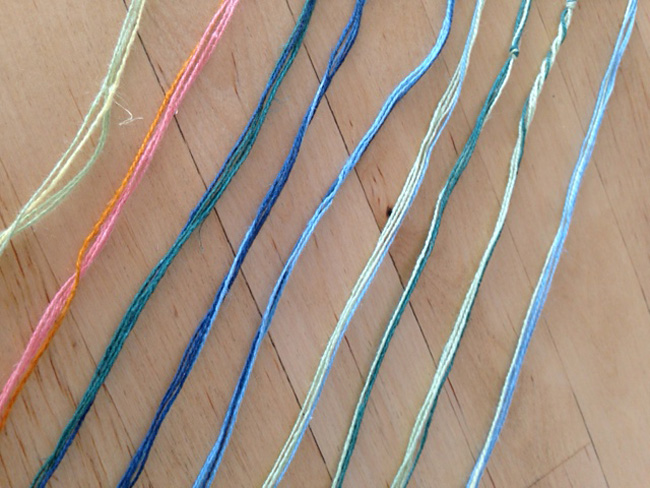
Then, you guessed it, I sample. In the Deep Fall 2015 Get Warped column, I shared some tips for sampling. Sampling can be as simple as committing to your warp colors, but allowing a few extra inches to testing out your weft colors. If you are venturing into a big project such as a set of towels or a throw, it pays to take the time to be sure you like your colors before proceeding. What looks good on the loom can change once the fabric is off the loom and washed.
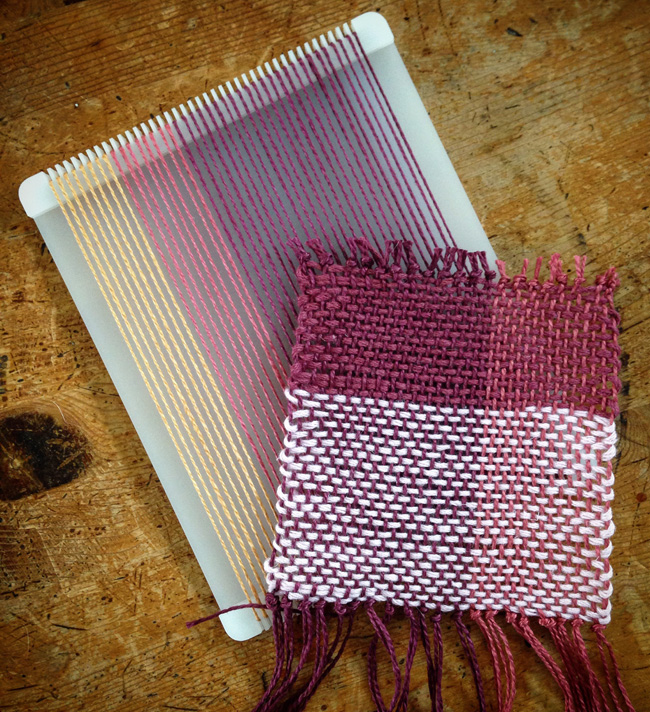
Color is a very personal choice. What is pleasing to one may not be pleasing to another. When my students are disappointed with their color decisions, it is often because of this intermingling that shifts the colors from skein to cloth. Disappointment is a relative term. If you set the project aside and come back with fresh eyes, you may have a much different opinion. Your initial reaction is wrapped up in not weaving what you expected, but that doesn't mean what you wove isn't beautiful. Just give it a little time and you may change your mind.
ABOUT THE DESIGNER
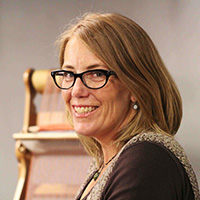 Liz Gipson is a lover of yarn and that from which it comes – namely the mills and fiber-bearing critters and plants. She is the author of the newly revised Weaving Made Easy and has four video workshops for rigid-heddle weaving published by Interweave. She is working on a new book, Handwoven Home, due out in the spring of 2017.
Liz Gipson is a lover of yarn and that from which it comes – namely the mills and fiber-bearing critters and plants. She is the author of the newly revised Weaving Made Easy and has four video workshops for rigid-heddle weaving published by Interweave. She is working on a new book, Handwoven Home, due out in the spring of 2017.
Curious about the warped side of yarn? Visit Liz's website Yarnworker, for know-how and inspiration, or hang out with her @yarnworker on Facebook, Twitter, Instagram and Ravelry.
Pattern & images © 2017 Liz Gipson. Contact Liz




